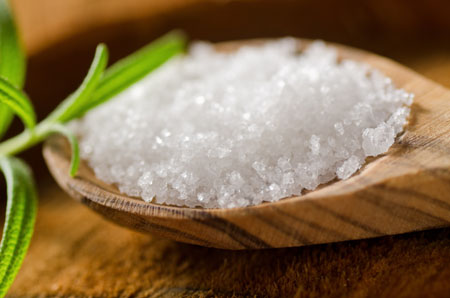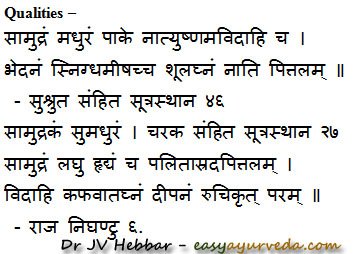Sea Salt Benefits, Usage, Dose, Side Effects – Ayurveda details
Sea salt produced from sea water. The seawater is canalized and Sun-dried. The technique of producing Sea salt varies according to different nations, depending on climate.

Table of Contents
Sea salt, table salt differences
Difference between sea salt and table salt:
Sea salt is from the sea, it contains natural minerals in trace amounts. The quantities of these minerals depends upon the sea. Table salt is mined out from the underground salt deposits. It is processed and refined to remove excess minerals. Then, it is added with iodine, to support thyroid gland. Table salt is also known as common salt.
Sea salt is called as Samudra lavana in Sanskrit.
Chemical composition
Chemical composition – Sodi muras – NaCl
Sea salt composition: Apart from sodium chloride, it also contains magnesium, potassium, calcium and sulphate.
Classification: Sea salt is one among Pancha lavana. (group of five salts) and Lavana Shastaka – group of six salts ()
Sanskrit verse

Qualities
Qualities of Samudra lavana:
Rasa – Taste – Saline, slightly sweet taste,
Vipaka – Post digestive change in taste – Sweet
Veerya – Potency – Slightly hot. (Na Ati ushna)
Guna – Qualities – Unctuous (oily) , light to digest
Effect on Tridosha – Balances Kapha and Vata.
Functions
Avidahi – It does not cause burning sensation in stomach.
Bhedana – it has cutting piercing action.
Ishat Snigdha – slightly oily, unctuous
Shulaghna – Useful in relieving abdominal colic.
Na Ati Pitta – All the salts, by nature increase Pitta dosha. But sea salt does not increase Pitta to a large extent, due to its slight sweet taste.
Laghu – light to digest
Hrudya – good for heart
Deepana – increases digestion strength.
Excessive intake may cause wrinkles, blood disorders.
Ruchikrut – improves taste of foods.
Effect on Doshas – Slightly increases Pitta, relieves abdomen pain of Kapha-Vata origin.
Ayurvedic medicines
Ayurvedic medicines containing sea salt as an ingredient:
Chitrakadi vati – Useful to improve digestion, in Ama – impaired digestion and metabolism.
Kalyana Kshara – Used in hemorrhoids, constipation, bloating etc.
Saubhagya Vati – Useful in cough, cold, bronchitis, asthma, anorexia, depression etc
Kalyana Gulam – Useful in skin diseases, jaundice, fatty liver changes, ascites etc.
Mahashankh Vati – Useful in the treatment of hemorrhoids, malabsorption syndrome, dyspepsia.
Dose, side effects
Dose: Recommended dose is – less than 2.3 grams per day.
Side effects: It is best to avoid more than 1.5 g of salt per day, wherever, sodium restricted diet is recommended, as in high blood pressure.
As per Ayurveda, excess use of any salt leads to imbalance of Pitta, blood vitiation and skin disorders.









3 comments
meera
My daily gloomy routine life has changed so much into a very happy peaceful journey. I am ever grateful to you and your articles posted. i use to take in so much chemical pills but not anymore, I just follow and impatiently wait for your emails. May Lord Krishna ever bless you and your teams.. Indeed the title chosen is well defined easy ayurvedic..Regards Meera
Dr J V Hebbar MD(Ayu)Author
Glad you find my work useful.
Dr Omana Mammen
thyroid problems are more after the usage of iodised salt. Why is this?